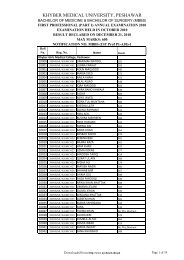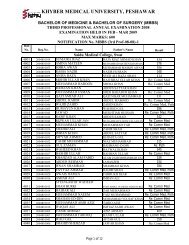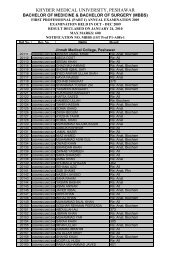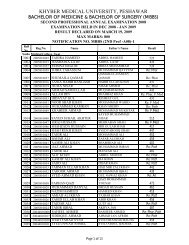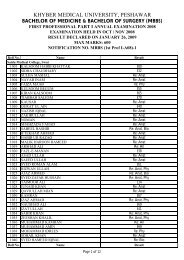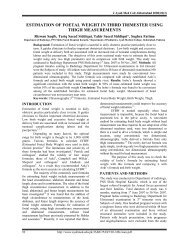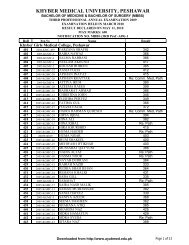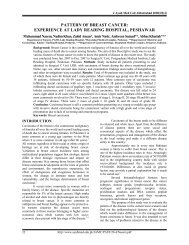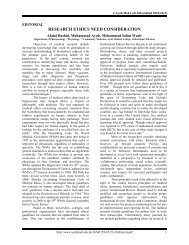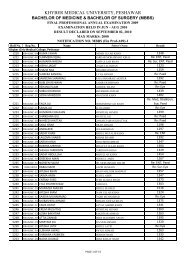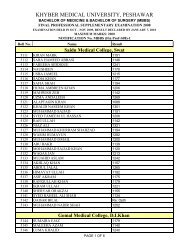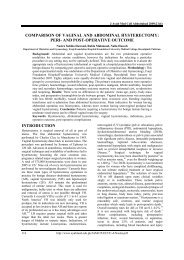closure of elective abdominal incisions with monofilament, non ...
closure of elective abdominal incisions with monofilament, non ...
closure of elective abdominal incisions with monofilament, non ...
Create successful ePaper yourself
Turn your PDF publications into a flip-book with our unique Google optimized e-Paper software.
J Ayub Med Coll Abbottabad 2011;23(2)<br />
ORIGINAL ARTICLE<br />
CLOSURE OF ELECTIVE ABDOMINAL INCISIONS WITH<br />
MONOFILAMENT, NON-ABSORBABLE SUTURE MATERIAL VERSUS<br />
POLYFILAMENT ABSORBABLE SUTURE MATERIAL<br />
Altaf Ahmed Talpur, Mohammad Sharif Awan*, Abdul Rasheed Surhio**<br />
Liaquat University <strong>of</strong> Medical and Health Sciences, Jamshoro, *People’s Medical College, Nawabshah, Pakistan<br />
Background: Closure <strong>of</strong> <strong>abdominal</strong> <strong>incisions</strong> <strong>with</strong> different suture materials has been a matter <strong>of</strong> great<br />
controversy. Polypropylene and Polylactide <strong>with</strong> Polyglycolide are among the commonest suture<br />
materials used for <strong>closure</strong> <strong>of</strong> <strong>abdominal</strong> <strong>incisions</strong>. Objectives <strong>of</strong> this study were to assess optimal suture<br />
material used for <strong>closure</strong> <strong>of</strong> <strong>elective</strong> <strong>abdominal</strong> <strong>incisions</strong> and to see complications associated <strong>with</strong> these<br />
suture materials. Methods: This prospective, comparative, randomised study was conducted at public<br />
and private sector hospitals <strong>of</strong> Nawabshah and Hyderabad from 1 st Jan 2005 to 31 st October 2009. All<br />
patients who underwent <strong>abdominal</strong> surgery under the investigators’ supervision were included in the<br />
study. Patients were divided into 2 groups on even or odd numbers. In group-A patients’ incision was<br />
closed <strong>with</strong> mon<strong>of</strong>ilament, <strong>non</strong>-absorbable Polypropylene (Prolene) No. 1 suture material and in group-<br />
B incision was closed <strong>with</strong> Polyfilament, absorbable, co-polymer <strong>of</strong> Polylactide <strong>with</strong> Polyglycolide<br />
(Vicryle) No. 1. Results: A total 274 patients were finally analysed for <strong>closure</strong> <strong>of</strong> <strong>elective</strong> <strong>abdominal</strong><br />
<strong>incisions</strong>, <strong>with</strong> 138 (50.4%) patients in Group-A and 136 (49.6%) patients in Group-B. Vicryle was<br />
found superior in knot security and suture handling. Superficial wound infection was found in 5.79%<br />
patients <strong>of</strong> Group-A and 6.61% <strong>of</strong> Group-B. Discharging sinus was found in 3.62% <strong>of</strong> Group-A vs<br />
0.73% <strong>of</strong> Group-B. Burst abdomen was seen in 2.17% patients in Group-A and 1.47% in Group-B.<br />
Incisional hernia was present in 4.34% <strong>of</strong> Group-A and 0.73% patients <strong>of</strong> Group-B. No patient in<br />
Group-B developed persistent pain at incisional site while it was found in 8.69% patients <strong>of</strong> Group-A.<br />
Conclusion: Polylactide is an optimal suture material in <strong>closure</strong> <strong>of</strong> <strong>elective</strong> <strong>abdominal</strong> <strong>incisions</strong>.<br />
Keywords: <strong>elective</strong>, <strong>incisions</strong>, mon<strong>of</strong>ilament, polyfilament, suture, postoperative, complications<br />
INTRODUCTION<br />
Approximately 700,000 open <strong>abdominal</strong> procedures are<br />
performed annually in Germany and 4,000,000 in United<br />
States. 1 After <strong>abdominal</strong> <strong>incisions</strong>, patient’s skin has<br />
always to be closed separately, either at the time <strong>of</strong><br />
operation or at a few days later. There are two other<br />
layers to be closed, i.e., peritoneum, which is attached to<br />
posterior rectus sheath in case <strong>of</strong> midline <strong>incisions</strong> or<br />
inner muscular layers in case <strong>of</strong> lateral <strong>incisions</strong>, and<br />
anterior rectus sheath in case <strong>of</strong> midline wound or<br />
muscular layers in laterally placed <strong>incisions</strong>. 2,3 These<br />
layers are usually closed in two-layers <strong>with</strong> the skin as<br />
second layer. However, they can also be closed in<br />
classical three layers, i.e., peritoneum as first layer;<br />
muscles, rectus sheath or linea alba as second layer, and<br />
skin as third layer. 4,5<br />
Different types <strong>of</strong> suture materials are used for<br />
<strong>closure</strong> <strong>of</strong> <strong>abdominal</strong> <strong>incisions</strong>. There has been<br />
continuous debate on results <strong>of</strong> mon<strong>of</strong>ilament<br />
(polypropylene) <strong>with</strong> polyfilament (co-polymer <strong>of</strong><br />
polyglycolide and polylactide) suture materials.<br />
In prospective studies, the incidence <strong>of</strong><br />
incisional hernia varies from 9%–20%. Wound infection,<br />
obesity, suture <strong>closure</strong> technique is mentioned as major<br />
risk factors for the development <strong>of</strong> incisional hernia.<br />
Whereas patients related factors such as, age, gender,<br />
body mass index, underlying disease or co-morbid<br />
illness, prior surgical procedures and life style factors<br />
(e.g., smoking) cannot be controlled or standardised, the<br />
decisive chance to lower the incidence <strong>of</strong> complications,<br />
especially incisional hernia is to optimise the surgical<br />
technique. Therefore, great variety <strong>of</strong> suture materials<br />
and needles has been developed to provide an adequate<br />
<strong>closure</strong> <strong>of</strong> the fascia and thus the <strong>abdominal</strong> wall. 5–8 Due<br />
to these facts <strong>closure</strong> <strong>of</strong> <strong>abdominal</strong> <strong>incisions</strong> is still a<br />
matter <strong>of</strong> great debate. Despite advances in surgical<br />
techniques and materials, <strong>abdominal</strong> fascia <strong>closure</strong> has<br />
remained a procedure that <strong>of</strong>ten reflects a surgeon’s<br />
personal preference <strong>with</strong> reliance on tradition and<br />
anecdotal experience. 9,10<br />
Many studies have been done to see different<br />
postoperative complications <strong>with</strong> each <strong>of</strong> these suture<br />
materials, but <strong>non</strong>e <strong>of</strong> these have been able to determine<br />
the definite superiority <strong>of</strong> one technique <strong>of</strong> <strong>abdominal</strong><br />
wall <strong>closure</strong> <strong>with</strong> mon<strong>of</strong>ilament or polyfilament.<br />
Our primary object was to compare<br />
postoperative wound complications associated <strong>with</strong> each<br />
<strong>of</strong> these suture materials. We also assessed suture<br />
handling properties and knot securities.<br />
MATERIAL AND METHODS<br />
This prospective, comparative randomised study was<br />
conducted at public and private sector hospitals <strong>of</strong><br />
Nawabshah and Hyderabad from 1 st Jan 2005 to 31 st<br />
Oct 2009. During this period all patients <strong>of</strong> either sex<br />
http://www.ayubmed.edu.pk/JAMC/23-2/Talpur.pdf 51
J Ayub Med Coll Abbottabad 2011;23(2)<br />
above the age <strong>of</strong> 13 years having <strong>elective</strong> <strong>abdominal</strong><br />
surgery under authors’ supervision were included in<br />
the study. Patients below the age <strong>of</strong> 13 years, having<br />
serious co-morbid illness like ischemic heart disease,<br />
severe chronic obstructive airway disease, and chronic<br />
liver disease were excluded. Patients who presented in<br />
acute illness and were found to have peritonitis or<br />
having gross visceral infection were also excluded.<br />
Patients who lost to follow-up were excluded.<br />
These patients were divided into 2 groups<br />
according to odd or even numbers. In Group-A<br />
patients’ <strong>abdominal</strong> incision was closed <strong>with</strong><br />
mon<strong>of</strong>ilament, <strong>non</strong>-absorbable polypropylene<br />
(Prolene) suture No. 1 and in patients <strong>of</strong> Group-B, the<br />
<strong>abdominal</strong> wall was closed <strong>with</strong> polyfilament,<br />
absorbable, co-polymer <strong>of</strong> polyglycolide <strong>with</strong><br />
Polylactide (Vicryle) No. 1.<br />
The patients were admitted in ward. Detailed<br />
history was taken and thorough examination was<br />
performed <strong>with</strong> special focus on variables like<br />
anaemia, jaundice, weight, general health, any<br />
previous scar on abdomen. Investigations were<br />
performed to establish diagnosis and to assess general<br />
fitness. Complete blood count, blood sugar, blood urea<br />
and where required ECG and chest X-ray were done.<br />
In addition ultrasound abdomen, CT scan, intravenous<br />
urography, gastoduodenoscopy, or contrast studies <strong>of</strong><br />
gut were performed when indicated. Informed written<br />
consent was obtained.<br />
Similar antibiotic prophylaxis was used in<br />
both groups at the time <strong>of</strong> induction <strong>of</strong> anaesthesia and<br />
switched to oral antibiotics once oral feeding was<br />
tolerated. In all patients except <strong>of</strong> flank <strong>incisions</strong>,<br />
wound was closed in 2 layers, <strong>with</strong> the skin being the<br />
2 nd layer. In cases <strong>of</strong> flank incision wound was closed<br />
in 3 layers <strong>with</strong> muscles in 2 layers and the skin as the<br />
3 rd layer.<br />
During <strong>closure</strong> <strong>of</strong> incision properties <strong>of</strong><br />
suture material like handling properties and knot<br />
security were assessed. Postoperatively Incision was<br />
examined usually on 5 th postoperative day. However it<br />
was seen earlier in cases when dressing became soaked<br />
or patient developed fever or tachycardia and no other<br />
source <strong>of</strong> fever or tachycardia was found. Patients<br />
were discharged from hospital once oral feeding was<br />
tolerated well and patients became freely mobile. Skin<br />
stitches were removed on 9 th postoperative day in<br />
outpatient clinics. In patients who underwent midline<br />
<strong>incisions</strong> and were obese, chronic smokers or<br />
chronically constipated <strong>abdominal</strong> belts were advised<br />
for 3 months postoperatively. Follow-up visits were<br />
advised at 1, 3 and 6 months. Postoperatively these<br />
patients were assessed for complications related to<br />
<strong>abdominal</strong> incision.<br />
Patients’ data was recorded on a pre-designed<br />
Performa. All data were analysed for categorical and<br />
continuous variables like age, sex, properties <strong>of</strong> suture<br />
materials, and postoperative wound complications<br />
especially in relation to type <strong>of</strong> suture material used for<br />
<strong>closure</strong> <strong>of</strong> <strong>abdominal</strong> wall. Statistical tests were<br />
applied and p-value was calculated using SPSS-11.<br />
RESULTS<br />
A total <strong>of</strong> 274 patients were finally analysed in this<br />
study, <strong>with</strong> 138 (50.4%) patients in Group A and 136<br />
(49.6%) patients in Group-B. Mean age <strong>of</strong> both groups<br />
<strong>of</strong> patients was 42.43±14.09 years (13–76 years). Male<br />
patients were 117 (42.7%) and female were 157<br />
(57.3%). Mean weight was 59.97±13.32 Kg (29–98<br />
Kg). Regarding pathology, kidneys and upper ureters<br />
were involved in 96 (35%) patients, gall bladder and<br />
common bile duct disease in 91 (33.2%) patients,<br />
urinary bladder, prostate, and lower ureters in 27 (9.9%)<br />
patients, small and large bowel pathology in 23 (8.4%)<br />
patients, ovarian mass or cyst in 15 (5.5%) patients,<br />
uterine pathology in 10 (3.6%) patients, retro-peritoneal<br />
mass in 5 (1.8%) patients, stomach pathology in 4<br />
(1.5%) patients, and lower part <strong>of</strong> oesophagus in 3<br />
(1.1%) patients (Table-1).<br />
Co-morbid illness was found in 68 (24.8%)<br />
patients. Amongst them, 27 (39.70%) patients<br />
developed postoperative wound complications. It<br />
included 12 (17.14%) patients <strong>of</strong> diabetes mellitus, 8<br />
(11.76%) patients <strong>of</strong> hypertension, 5 (7.35%) patients <strong>of</strong><br />
bronchial asthma and 1 (1.47%) patient each <strong>of</strong><br />
ischemic heart disease and miscellaneous group.<br />
Flank incision was the most common incision<br />
that was made in 96 (35%) patients, followed by right<br />
sub-costal <strong>incisions</strong> in 91 (33.2%) patients. Lower<br />
midline incision was made in 52 (19%) patients,<br />
conventional midline incision in 28 (10.2%) patients, and<br />
upper midline incision in 7 (2.6%) patients (Table-2).<br />
All <strong>incisions</strong> were closely observed during the<br />
postoperative hospital course and at outpatient clinics on<br />
follow-up visits at 1, 3 and 6 months. Any wound<br />
complication was noted. Thirty-four (24.63%) patients<br />
in the mon<strong>of</strong>ilament group and 13 (9.55%) patients in<br />
the polyfilament group developed wound complications.<br />
Seventeen (6.20%) patients developed superficial<br />
wound infection, including 9 (6.61%) patients <strong>of</strong><br />
polyfilament group and 8 (5.79%) patients <strong>of</strong><br />
mon<strong>of</strong>ilament group. Six (2.18%) patients developed<br />
discharging sinus that included 5 (3.62%) patients <strong>of</strong><br />
mon<strong>of</strong>ilament group and 1 (0.73%) patient <strong>of</strong><br />
polyfilament group. Burst abdomen was seen in 5<br />
(1.82%) patients, 3 (2.17%) patients <strong>of</strong> mon<strong>of</strong>ilament<br />
group and 2 (1.47%) patients <strong>of</strong> polyfilament group.<br />
Incisional hernia developed in 7 (2.55%) patients<br />
including 6 (4.34%) patients <strong>of</strong> mon<strong>of</strong>ilament group and<br />
1 (0.73%) patients <strong>of</strong> polyfilament group. Persistent<br />
pain was present only in mon<strong>of</strong>ilament group in 12<br />
(8.69%) patients (Table-3).<br />
52<br />
http://www.ayubmed.edu.pk/JAMC/23-2/Talpur.pdf
J Ayub Med Coll Abbottabad 2011;23(2)<br />
Table-1: Pattern <strong>of</strong> visceral pathology in patients<br />
Pathology Number (%)<br />
Kidneys and Upper Ureter 96 (35)<br />
Gall Bladder & Common Bile Duct 91 (33.2)<br />
Urinary Bladder, Prostate, and Lower Ureter 27 (9.9)<br />
Small and Large Bowel 23 (8.4)<br />
Ovarian Mass or Cyst 15 (5.5)<br />
Uterine Pathology 10 (3.6)<br />
Retroperitoneal Mass 5 (1.8)<br />
Stomach Pathology 4 (1.5)<br />
Pathology <strong>of</strong> Lower part <strong>of</strong> Oesophagus 3 (1.1)<br />
Table-2: Type <strong>of</strong> <strong>incisions</strong> used in the study<br />
Type <strong>of</strong> Incision Number (%)<br />
Flank Incision 96 (35)<br />
Right Sub-costal Incision 91 (33.2)<br />
Lower midline Incision 52 (19)<br />
Conventional Midline Incision 28 (10.2)<br />
Upper Midline Incision 7 (2.6)<br />
Table-3: Comparative analysis <strong>of</strong> postoperative wound complications <strong>with</strong> mon<strong>of</strong>ilament and polyfilament<br />
suture materials (n=274)<br />
Suture Materials<br />
Postoperative wound complications Mon<strong>of</strong>ilament (n=138) Polyfilament (n=136) Total p<br />
Nil 104 (75.36%) 123 (90.4%) 227 (82.8%)<br />
Superficial Wound Infections 8 (5.79%) 9 (6.61%) 17 (6.20%)<br />
Discharging Sinus 5 (3.62%) 1 (0.73%) 6 (2.18%)<br />
Burst Abdomen 3 (2.17%) 2 (1.47%) 5 (1.82%)<br />
Incisional Hernia 6 (4.34%) 1 (0.73%) 7 (2.55%)<br />
Persistent Pain 12 (8.69%) 0 12 (4.37%)<br />
Total 34 (24.63%) 13 (9.55%) 47 (17.15%)<br />
DISCUSSION<br />
Although there are substantial number <strong>of</strong> randomised<br />
studies and several meta-analysis examining different<br />
techniques <strong>of</strong> <strong>abdominal</strong> fascia <strong>closure</strong> the optimal<br />
and better method <strong>of</strong> closing the abdomen has not yet<br />
been found. 6,7,11 Therefore the technique and<br />
material for <strong>abdominal</strong> fascia <strong>closure</strong> are still<br />
determined by local material supply and surgical<br />
traditions. Regarding optimal method <strong>of</strong> <strong>abdominal</strong><br />
<strong>closure</strong> a variety <strong>of</strong> factors have to be considered like<br />
wound infection, wound dehiscence, incisional<br />
hernia, suture sinus, and pain. 12<br />
Most common complication noted in this study<br />
was superficial wound infection which is the only<br />
complication found slightly more in patients <strong>of</strong><br />
polyglycolide group. Polyglycolide is a braided, material<br />
having half life <strong>of</strong> 20–30 days and chances <strong>of</strong> infection is<br />
more in this group <strong>of</strong> patients as harbouring organisms is<br />
more in this types <strong>of</strong> suture material than mon<strong>of</strong>ilament<br />
suture materials. 13 Choudhary et al 12 demonstrated<br />
wound infection in 22.5% patients <strong>of</strong> mon<strong>of</strong>ilament mass<br />
<strong>closure</strong> <strong>of</strong> <strong>abdominal</strong> <strong>incisions</strong>. They found sinus<br />
formation in 2% patients <strong>of</strong> mon<strong>of</strong>ilament group, while<br />
in our study it was found in 3.62% patients <strong>of</strong><br />
mon<strong>of</strong>ilament group and in only 0.73% patients <strong>of</strong><br />
polyfilament group.<br />
The meta-analysis by Hodgson et al 14 reported<br />
less incisional hernias after <strong>closure</strong> <strong>with</strong> continuous <strong>non</strong>absorbable<br />
sutures but also found significantly more<br />
suture sinuses and wound pain requiring further<br />
interventions.<br />
Our study demonstrated burst abdomen in<br />
2.17% patients <strong>of</strong> prolene group and 1.47% patients <strong>of</strong><br />
polyfilament group. In a study by Gys et al 15 found burst<br />
abdomen in 3% patients <strong>of</strong> prolene group and 1.9%<br />
patients <strong>of</strong> polyglycolide group.<br />
0.001<br />
In our series incidence <strong>of</strong> incisional hernia was<br />
significantly more common in mon<strong>of</strong>ilament group, i.e.,<br />
in 4.34% patients while it was found only in 0.73%<br />
patients <strong>of</strong> polyglycolide group. Gys et al 15 found<br />
incisional hernia in 6% patients <strong>of</strong> each group.<br />
Persistent pain at either end <strong>of</strong> wound was<br />
found only in mon<strong>of</strong>ilament group in which it was found<br />
in 8.69% patients, which may be due to the knot present<br />
at these sites.<br />
CONCLUSION<br />
Vicryle is an optimal suture material for <strong>closure</strong> <strong>of</strong><br />
<strong>elective</strong> <strong>abdominal</strong> <strong>incisions</strong>. Complications like burst<br />
abdomen, discharging sinus, incisional hernia, and<br />
persistent pain are more common <strong>with</strong> Prolene.<br />
Properties <strong>of</strong> suture handling and knot security are also<br />
superior <strong>with</strong> Vicryle. Superficial wound infection is<br />
found slightly more in the Vicryle group.<br />
REFERENCES<br />
1. Conze J, Klinge U, Schumpelick V. Incisional Hernia. Chirurg<br />
2005;76:897–909.<br />
2. Leaper DJ, Winslet MC. Basic surgical skills and anastomosis.<br />
In: Bailey and Love’s Short Practice <strong>of</strong> Surgery. 24 th Ed. 2004,<br />
Vol. 1, pp. 98–9, 1186–90.<br />
3. Kirk RM, Williamson RCN. Laparotomy; <strong>elective</strong> and<br />
emergency. In: Krik RM, (Ed). General surgical operations, 4 th<br />
Ed. Edinburgh: Churchill Livingstone; 2000, 81–6, 89–92.<br />
4. Johnstone JMS, Rintoul RF. Abdominal surgery: access and<br />
procedures. In: Farquharsons Textbook <strong>of</strong> Operative Surgery. 8 th<br />
Edition. UK: Churchill Livingstone; 1995. p.338–40.<br />
5. Cusheri A. Disorders <strong>of</strong> <strong>abdominal</strong> wall and peritoneal cavity. In:<br />
Cusheri A, Steele RJC, Moosa AB, editors. Essential Surgical<br />
Practice. 4 th ed. London: Arnold; 2002. p. 143–82.<br />
6. Weiland DE, Bay RC, Del Sordi S. Choosing the best <strong>abdominal</strong><br />
<strong>closure</strong> by meta- analysis. Am J Surg 1998;176:666–70.<br />
7. Rucinski J, Margolis M, Panagopoulos G, Wise L. Closure <strong>of</strong><br />
midline <strong>abdominal</strong> fascia. Meta-analysis delineates the optimal<br />
technique. Am Surg 2001;67(5):421–6.<br />
http://www.ayubmed.edu.pk/JAMC/23-2/Talpur.pdf 53
J Ayub Med Coll Abbottabad 2011;23(2)<br />
8. Yahchonchy-Chonillard E, Aura T, Piccone O, Etienne JC,<br />
Fingerhut A. Incisional hernia, Related risk factors. Dig Surg<br />
2003;20:3–9.<br />
9. Knaebel HP, Koch M, Sauerland S, Diener MK, Büchler MW,<br />
Seiler CM; INSECT Study Group <strong>of</strong> the Study Centre <strong>of</strong> the<br />
German Surgical Society. Interrupted or continuous slowly<br />
absorbable sutures, Multi-centre randomized trial to evaluate<br />
<strong>abdominal</strong> <strong>closure</strong> technique INSECT-Trial. BMC Surg<br />
2005;5:3.<br />
10. Ceydeli A, Rucinski J, Wise L, Finding the best <strong>abdominal</strong><br />
<strong>closure</strong>: An evidenced-based review <strong>of</strong> the literature. Curr Surg<br />
2005;62:220–5.<br />
11. Van’t Riet M, Steyerberg EW, Nellensteyn J, Bonjer HJ, Jeekel<br />
J. Meta-Analysis <strong>of</strong> technique for <strong>closure</strong> <strong>of</strong> midline <strong>abdominal</strong><br />
<strong>incisions</strong>. Br J Surg 2002;89:1350–6.<br />
12. Choudhary SK, Choudhary SD. Mass <strong>closure</strong> vs. layered <strong>closure</strong><br />
<strong>of</strong> <strong>abdominal</strong> wound: a prospective clinical study. J Indian Med<br />
Assoc 1994;92:229–32<br />
13. McLean S, Kreamer B. Wound care and healing. The<br />
Washington manual <strong>of</strong> Surgery, 3 rd Edi. USA: Lippincott<br />
Williams & Wilkins; 2002.p. 176–7.<br />
14. Hodgson NC, Mathaner RA, Ostbye T. The search for an ideal<br />
method <strong>of</strong> an <strong>abdominal</strong> fascia <strong>closure</strong>, a meta-Analysis. Ann<br />
Surg 2000;231:436–42.<br />
15. Gys T, Hubens A. A prospective, comparative clinical study<br />
between mon<strong>of</strong>ilament absorbable and <strong>non</strong>-absorbable sutures<br />
for <strong>abdominal</strong> wall <strong>closure</strong>. Acta Chir Belg 1989;89:265–70.<br />
Address for Correspondence:<br />
Dr. Altaf Ahmed Talpur, Flat No. A-202, Fort Sultan Apartments, Opposite Airport Telephone Exchange, Main<br />
Shahra-e-Faisal, Karachi, Pakistan. Tel: +92-21-34570819, Cell: +92-300-2185479, +92-313-3120299<br />
Email: altafktalpur@yahoo.com<br />
54<br />
http://www.ayubmed.edu.pk/JAMC/23-2/Talpur.pdf



